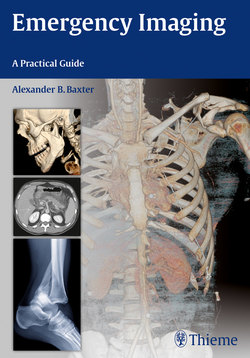Читать книгу Emergency Imaging - Alexander B. Baxter - Страница 109
На сайте Литреса книга снята с продажи.
Оглавление97
3 Head and Neck
inferior orbital rims, intersecting at the glabella. The fracture follows an oblique course from the bridge of the nose to the pterygoid plates and separates the maxilla, anterior nasal bones, and anterior orbital fl oor and rim from the remainder of the skull. Le Fort II fractures do not involve the lateral orbital walls or zygomatic arches. The absence of an infraorbital rim fracture excludes a Le Fort II injury.
Le Fort III fractures separate the entire midface from the cranium and involve the pterygoid plates, the orbital walls, and the zygomatic arches. The fracture passes horizontally and posteriorly through the nasofrontal suture, frontomaxillary su-ture, lateral orbital wall, zygomatic arches, and pterygoid plates. Zygomatic arch frac-ture, best visualized on axial CT images, is unique to a Le Fort III fracture, and its ab-sence excludes the diagnosis (Fig. 3.6).
◆Le Fort Fractures
The sine qua non of a Le Fort fracture is involvement of the pterygoid plates, and all Le Fort fractures e ectively separate a portion of the midface from the cranium. Le Fort I, II, and III patterns often occur in combination and can overlap with other complex fracture patterns such as mid-face smash, naso-orbito-ethmoid, and ZMC (Fig. 3.5).
The Le Fort I fracture is a horizontal max-illary fracture that traverses the pterygoid plates, inferior maxillary sinus, and nasal septum, separating the teeth and maxillary alveolus from the upper face. This injury can often be diagnosed on physical exam based on isolated mobility of the hard pal-ate. Le Fort I fractures always involve the inferior maxillary sinus walls and do not extend to the orbits or upper nasal bones.
Le Fort II is a pyramidal midface frac-ture that involves the maxillary antra and
Fig. 3.6a–fa,b Le Fort I. Transverse fracture of the maxilla with involvement of the inferior maxillary sinuses and nasal septum. The orbits and upper maxillae are intact.
c,d Le Fort II. Pyramidal fracture of the inferior orbital rims, anterior maxillary sinus walls, and nasal bridge.
e,f Le Fort III. Severely comminuted bilateral pterygoid, orbital wall, and zygomatic arch fractures. Exten-sive orbital emphysema. Severe comminution re ects overlap with midface smash pattern.
Fig. 3.5 Le Fort I, II, and III patterns.
a
b
